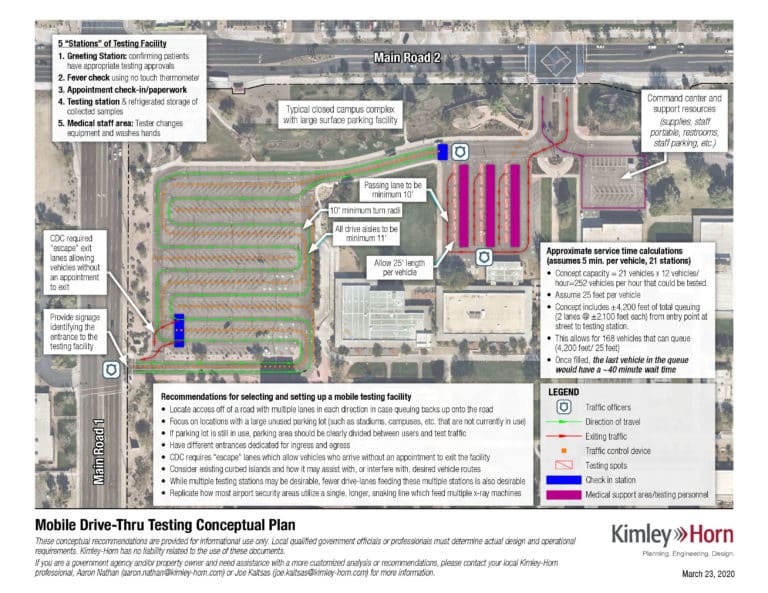- April 6, 2020
- COVID-19, Perspectives
Best Practices for Setting Up COVID-19 Mobile Testing Facilities
If you are asked to assist with the setup and mobilization of mobile or drive-thru testing facilities to help curb the spread of COVID-19, here are some best practices to inform smoother operational flow and increase the efficiency and well-being of all. Improving the operations of these facilities—even slightly—will help our healthcare professionals do their jobs and help our communities battle this pandemic.
This conceptual plan is based on the latest information available and subject to future changes in government guidelines.
Selecting a Testing Site
While each location is unique and local conditions will vary, select a site with a large unused parking lot, such as stadiums and campuses, whenever possible. We have also assisted with smaller testing facilities, though the testing volume is much less. If the parking lot is still in use, there should be a clear divide between parked cars and testing site traffic. Additionally, ensure the parking lot is located off an access road with multiple lanes if possible in case the queue causes traffic to back up onto the street.
The above graphic represents a conceptual/planning level traffic control schematic for a hypothetical mobile testing facility within a large vacant parking lot or similar paved area.
Dedicating Entry and Exit Points
Dedicate each access point as either an entrance or an exit and provide clear signage. The CDC also requires “escape” lanes to allow vehicles without an appointment to exit the testing site.
Determining Site Layout and Lane Size
When determining the layout of the testing site, consider existing curbed islands and how they may either assist or interfere with desired vehicle routes.
The command center—where support staff, restrooms, resources, and additional supplies are stored—should be positioned within walking distance of the medical testing stations and near a facility exit so traffic in and out does not interrupt the vehicle queue.
Drive aisles should be a minimum of 11 feet wide with a minimum turn radius of 10 feet to prevent collisions with other vehicles in the queue. All mobile testing facilities should be laid out with a one-way queue lane, while still allowing vehicles to exit the facility in an orderly fashion.
Configuring the Testing Stations
While multiple testing stations may increase the efficiency of the COVID-19 mobile testing facility, limit the number of drive lanes feeding into the test stations. When space permits, we recommend using a single, long, snaking lane—like airport security areas—to feed multiple testing stations.
Keep a distance of at least 25 feet between vehicles as they pull up to testing stations. The passing lane for vehicles to pull up to an open station should be at least 10 feet wide.
Calculating Service Time
Volume of vehicles per hour
=
Number of Testing Stations
x
60 minutes per hour
# of minutes per vehicle
The time it takes for the last vehicle to get through a full queue
=
Total length of vehicle queue
Volume of vehicles per hour

